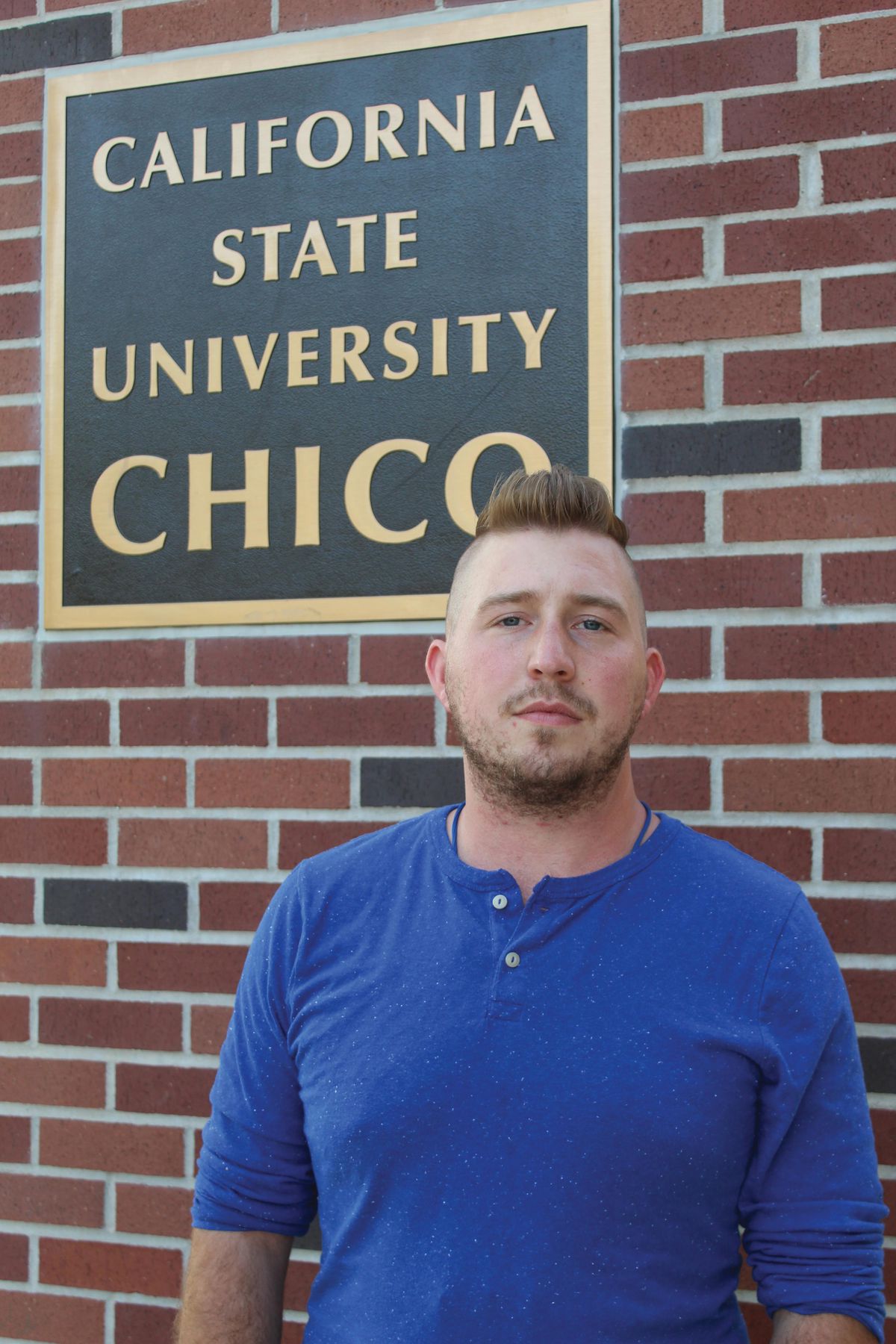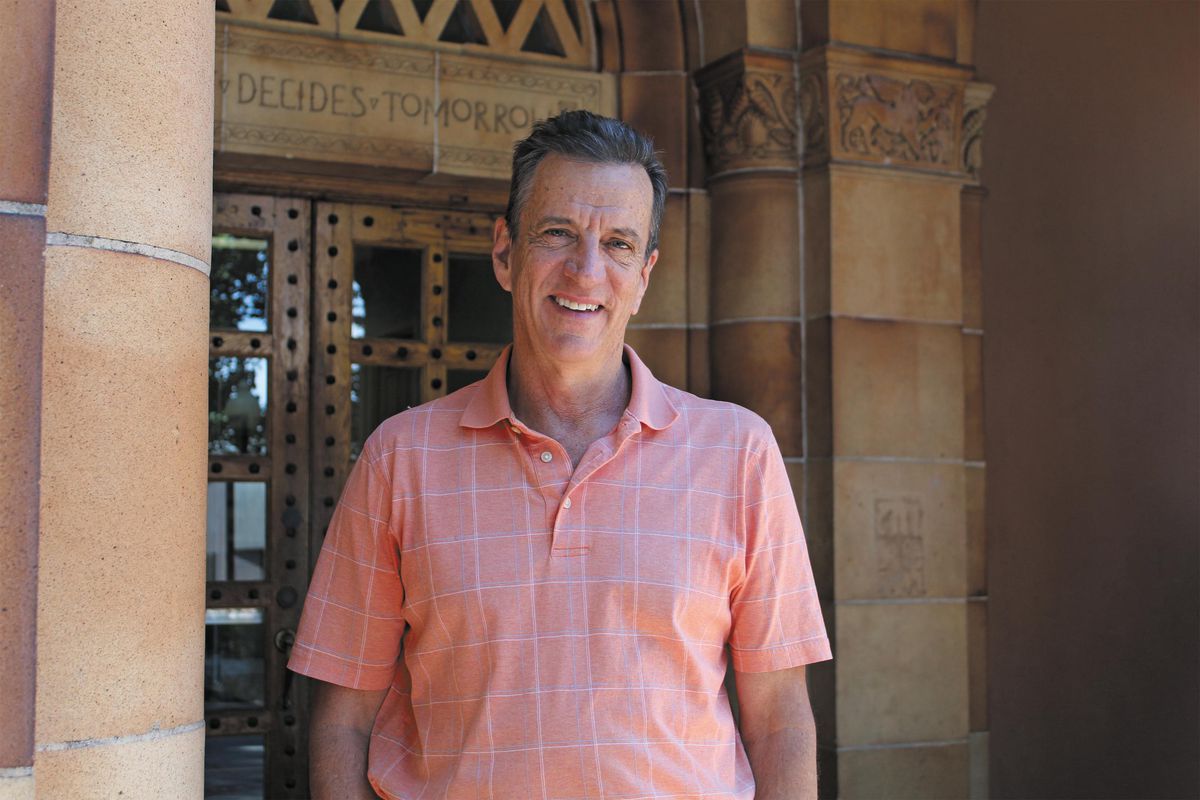Chico State student James Troupe has been couchsurfing.
He says he knows he can stay with his parents—they’ve invited him to come home. But right now, home is an RV parked at their property in Oroville, where they are building a new house since their place on the Ridge was destroyed in the Camp Fire.

Photo by Ashiah Scharaga
James Troupe has been homeless since early August while searching for housing in Chico.
“I’m always welcome to sleep there, but having me and my dog in their already small little fifth-wheel—they already have two dogs in there—it’s burdensome for them,” Troupe said.
Troupe, who grew up in Paradise, lived in a run-down home adjacent to Chico State the past two years while going to school. When that living arrangement ended this summer, he began crashing here and there as he looked for a long-term option. It’s been a frustrating and fruitless search thus far, he said.
“All my stuff is in boxes at my friends’ houses and just getting up and finding something clean to wear can be hard at times,” Troupe said.
The rental market was tight before the fire—with about a 3 percent vacancy rate in October—but it has become more constricted since then, as Camp Fire survivors have had no choice but to find new places to live, including in what is traditionally considered student housing. Then came a second wave of displacement, as landlords around the region began selling their properties.
Many displaced renters have moved out of the area, to other counties and even out of state. As for the enrollment at Chico State, preliminary data show it has dropped for fall 2019. As of Aug. 5, approximately 17,200 students are attending; about 16,150 are full-time. Compared with fall 2018—when there were 17,475 students, 16,435 of them full-time—that’s a 1.3 percent and 1.7 percent decrease, respectively.
The most significant drop is in first-year students: The incoming freshman class is down 8.3 percent. Transfer-student enrollment increased 2.8 percent and graduates remained about the same.
Even still, there’s no shortage of students who, like Troupe, are frantically seeking a place. Take one group from Facebook with over 2,000 members, the Chico Student Housing 2019-2020 Roommate Search: Some students have been searching for weeks with no luck, others have had a living situation fall through at the last minute. Several try to advertise themselves as being flexible, writing that they’re willing to share rooms. One poster even said he’d live “under any social conditions.” As the semester approaches, ASAPs and exclamation points are ubiquitous.
A Chico State student housing study dated spring 2019 by consultant The Scion Group concluded that the off-campus rental market adjacent to the university appears to be keeping pace with demand post-fire. However, availability is decreasing in that particular region, and the average vacancy rate is predicted to be roughly 4 percent this academic year, the study notes. Citywide, there are very few rentals open.
On the positive side, the university was trying to address rental shortages prior to the fire. As a result, there will be more beds available for students on campus this year, University Housing Director Connie Huyck told the CN&R (see sidebar). Plus, over the next 10 years, the university plans to add 1,400 more student beds.
In the university’s Off-Campus Student Services, a division of Student Affairs, Director Dan Herbert has been fielding many calls and emails daily from students and parents worried about Chico’s post-Camp Fire rental market.
He told the CN&R that he immediately tries to quell their concerns: For the traditional student, there are plenty of housing options, he says. He works with local apartment complexes, and knows where to point students who aren’t sure where to go. In some cases, he has even played matchmaker for folks seeking roommates.
There are vacancies, he said, partly due to the resurgence of building in Chico in the past several years as the economy improved. Since 2016, 810 multifamily units and 34 duplex units have been built in Chico, according to data from the city’s building division. Last year alone, three large student-focused complexes went up along the Nord Avenue/Walnut Street corridor.
Catherine Wilcox, who manages the Timber Creek and Hidden Oaks apartments about a half-mile from campus, says she has noticed a tightening of the market post-Camp Fire. The Scion Group describes Timber Creek Apartments as “purpose-built student housing” because it is popular with students and within a mile of campus. (Wilcox told the CN&R that the complex rents to all qualified applicants.)
“We’re miles ahead of where we were last year in terms of leasing up,” she said. “Across the market in Chico, it’s so impacted, [renters] have to sort of rush their decision … because stuff goes much more quickly than it did in the past.”
The complexes, which have 149 units, took in 30 households from the Camp Fire between November and January. The property managers did their best to accommodate folks, waiving deposits and offering six-month leases with the option for renewal. Eighteen families are still there, Wilcox said.
As of the CN&R’s deadline, Troupe had two leads on housing. He noted, though, that affordability post-Camp Fire is also an issue.
“It seems like all the prices have gone up,” he said.
Herbert has worked for the university for five years and co-owned a local property management company from 2000 to 2014. He says it isn’t out of the ordinary for housing to be tougher to secure as the school year inches closer and the more popular or affordable units are snatched up. If affordability is an issue, he suggests that students consider sharing rooms, or he connects them with the university’s Basic Needs Project, which helps displaced or homeless students secure emergency and transitional housing and loans (see “Home at last,” Cover story, Aug. 16, 2018).
Herbert said a particular demographic has been struggling in this market: student couples and families. Because many may want to forgo typical student housing complexes, they end up competing with the rest of the renters in Chico.
“If there was a crisis in the student housing market, that’s the most prominent place it is, because they’re really in the market with everybody else in our community,” he said. “And we do have a housing crisis in Chico. Apartments have wait-lists right now.”

Photo by Ashiah Scharaga
Dan Herbert, Chico State director of Off-Campus Student Services, says for the traditional, single college student, there are plenty of housing options in Chico.
The Scion Group study confirms this, reporting that nontraditional student groups, including graduate students and those with families, were most impacted both pre- and post-Camp Fire.
The campus community discussed this issue during Chico State’s recent 2020-2030 master plan update outreach events. Mike Guzzi, associate vice president of facilities and capital projects, recalled hearing from a single mother who said she would love to be able to move into a family residence hall with her child. In the current market, she couldn’t afford to move out on her own, and was staying with relatives.
“Throughout the master planning process, we talked about that a lot: How do we get to a place where maybe we put enough beds … near the academic buildings, and [then] maybe we can convert portions of University Village for students with family housing? Because that’d be a more appropriate living environment for someone who has a family,” Guzzi said. “That’s a long-term goal we’d like to work towards.”
Those seeking to live on campus also face challenges every year: As of Aug. 6, even with the addition of 71 residence hall beds, there were 191 students on the wait-list, Huyck said—which is “a little high” for the time of year. It typically hovers between 150 to 200, she said.
The university sends updates to wait-listed students before school starts, she continued, but it’s hard to predict how much space might free up for a variety of reasons, including health or financial struggles or choosing another college.
“It’s tough, right? It’s this waiting game, because we don’t know how much movement there is going to be on the list,” she said.
Maria Zepeda, an incoming freshman from Ukiah, said she wasn’t too worried about housing at first, but when she discovered she was wait-listed behind dozens of other students for the residence halls, she started searching for an affordable room elsewhere. In July, Zepeda had the same experience over and over: She’d inquire about an available bedroom posted online, only to hear that there were four or five other people interested.
“[Finding housing] has been really weighing on me, and it’s been stressing my parents out as well. They’re like, ‘Are you going to have a place?’ And I’m like, ‘I don’t know. I’m trying my best.’ … Everybody’s looking for a place.”
